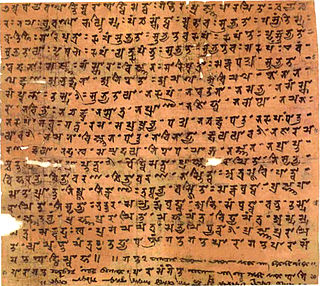
Devanagari is an Indic script used in the northern Indian subcontinent. Also simply called Nāgari, it is a left-to-right abugida, based on the ancient Brāhmi script. It is one of the official scripts of the Republic of India and Nepal. It was developed and in regular use by the 7th century CE and achieved its modern form by 1000 CE. The Devanāgari script, composed of 48 primary characters, including 14 vowels and 34 consonants, is the fourth most widely adopted writing system in the world, being used for over 120 languages.

Gurmukhī is an abugida developed from the Laṇḍā scripts, standardized and used by the second Sikh guru, Guru Angad (1504–1552). Commonly regarded as a Sikh script, Gurmukhi is used in Punjab, India as the official script of the Punjabi language.

Sanskrit is a classical language belonging to the Indo-Aryan branch of the Indo-European languages. It arose in South Asia after its predecessor languages had diffused there from the northwest in the late Bronze Age. Sanskrit is the sacred language of Hinduism, the language of classical Hindu philosophy, and of historical texts of Buddhism and Jainism. It was a link language in ancient and medieval South Asia, and upon transmission of Hindu and Buddhist culture to Southeast Asia, East Asia and Central Asia in the early medieval era, it became a language of religion and high culture, and of the political elites in some of these regions. As a result, Sanskrit had a lasting effect on the languages of South Asia, Southeast Asia and East Asia, especially in their formal and learned vocabularies.

The Brahmic scripts, also known as Indic scripts, are a family of abugida writing systems. They are used throughout the Indian subcontinent, Southeast Asia and parts of East Asia. They are descended from the Brahmi script of ancient India and are used by various languages in several language families in South, East and Southeast Asia: Indo-Aryan, Dravidian, Tibeto-Burman, Mongolic, Austroasiatic, Austronesian, and Tai. They were also the source of the dictionary order (gojūon) of Japanese kana.

Calligraphy is a visual art related to writing. It is the design and execution of lettering with a pen, ink brush, or other writing instrument. Contemporary calligraphic practice can be defined as "the art of giving form to signs in an expressive, harmonious, and skillful manner".

The Ahom script or Tai Ahom Script is an abugida that is used to write the Ahom language, a dormant Tai language undergoing revival spoken by the Ahom people till the late 18th-century, who established the Ahom kingdom and ruled the eastern part of the Brahmaputra valley between the 13th and the 18th centuries. The old Ahom language today survives in the numerous manuscripts written in this script currently in institutional and private possession.
Uchen is the upright, block style of the Tibetan script. The name means "with a head", and is the style of the script used for printing and for formal manuscripts.

The Guru Granth Sahib is the central holy religious scripture of Sikhism, regarded by Sikhs as the final, sovereign and eternal Guru following the lineage of the ten human gurus of the religion. The Adi Granth, its first rendition, was compiled by the fifth guru, Guru Arjan (1564–1606). Its compilation was completed on 29 August 1604 and first installed inside the Golden Temple in Amritsar on 1 September 1604. Baba Buddha was appointed the first Granthi of the Golden Temple. Shortly afterwards Guru Hargobind added Ramkali Ki Vaar. Later, Guru Gobind Singh, the tenth Sikh guru, added hymns of Guru Tegh Bahadur to the Adi Granth and affirmed the text as his successor. This second rendition became known as the Guru Granth Sahib and is also sometimes referred to as the Adi Granth.

Nastaliq, also romanized as Nastaʿlīq or Nastaleeq, is one of the main calligraphic hands used to write the Perso-Arabic script and it is used for some Indo-Iranian languages, predominantly Classical Persian, Kashmiri, Punjabi (Shahmukhi) and Urdu. It is often used also for Ottoman Turkish poetry, but rarely for Arabic. Nastaliq developed in Iran from naskh beginning in the 13th century and remains widely used in Iran, Afghanistan, India, Pakistan, and other countries for written poetry and as a form of art.

Jayadeva, also spelt Jaideva, was a Sanskrit poet during the 12th century. He is most known for his epic poem Gita Govinda which concentrates on Krishna's love with the gopi, Radha, in a rite of spring. This poem, which presents the view that Radha is greater than Krishna, is considered an important text in the Bhakti movement of Hinduism.

Islamic calligraphy is the artistic practice of handwriting and calligraphy, in the languages which use Arabic alphabet or the alphabets derived from it. It includes Arabic, Persian, Ottoman, and Urdu calligraphy. It is known in Arabic as khatt Arabi, which translates into Arabic line, design, or construction.

Khojkī, Khojakī, or Khwājā Sindhī, is a script used formerly and almost exclusively by the Khoja community of parts of the Indian subcontinent, including Sindh, Gujarat, and Punjab. However, this script also had a further reach and was used by members of Ismaili communities from Burma to East and South Africa. The Khojki script is one of the earliest forms of written Sindhi. The name "Khojki" is likely derived from the Persian word khoja, which means "master", or "lord".

Birch bark manuscripts are documents written on pieces of the inner layer of birch bark, which was commonly used for writing before the mass production of paper. Evidence of birch bark for writing goes back many centuries and appears in various cultures. The oldest such manuscripts are the numerous Gandhāran Buddhist texts from approximately the 1st century CE, from what is now Afghanistan. They contain among the earliest known versions of significant Buddhist scriptures, including a Dhammapada, discourses of Buddha that include the Rhinoceros Sutra, Avadanas and Abhidharma texts.

The Kufic script is a style of Arabic script that gained prominence early on as a preferred script for Quran transcription and architectural decoration, and it has since become a reference and an archetype for a number of other Arabic scripts. It developed from the Arabic alphabet in the city of Kufa, from which its name is derived. Kufic is characterized by angular, rectilinear letterforms and its horizontal orientation. There are many different versions of Kufic, such as square Kufic, floriated Kufic, knotted Kufic, and others. The artistic styling of Kufic led to its use in a non-Arabic context in Europe, as decoration on architecture, known as pseudo-Kufic.

The Bakhshali manuscript is an ancient Indian mathematical text written on birch bark that was found in 1881 in the village of Bakhshali, Mardan. It is perhaps "the oldest extant manuscript in Indian mathematics". For some portions a carbon-date was proposed of AD 224–383 while for other portions a carbon-date as late as AD 885–993 in a recent study, but the dating has been criticised by specialists on methodological grounds. The manuscript contains the earliest known Indian use of a zero symbol. It is written in a form of literary Sanskrit influenced by contemporary dialects.

Palm-leaf manuscripts are manuscripts made out of dried palm leaves. Palm leaves were used as writing materials in the Indian subcontinent and in Southeast Asia dating back to the 5th century BCE. Their use began in South Asia and spread to other regions, as texts on dried and smoke-treated palm leaves of the Palmyra or talipot palm. Their use continued until the 19th century when printing presses replaced hand-written manuscripts.

The Śāradā, Sarada or Sharada script is an abugida writing system of the Brahmic family of scripts. The script was widespread between the 8th and 12th centuries in the northwestern parts of Indian Subcontinent, for writing Sanskrit and Kashmiri. Although originally a signature Brahminical script created in the valley, it was more widespread throughout northwestern Indian subcontinent, although became later restricted to Kashmir, and it is now rarely used, except by the Kashmiri Pandit community for religious purposes.
Pecha is a Tibetan word meaning "book", but in particular, refers to the traditional Tibetan loose-leaf books such as the kangyur, tengyur, and sadhanas. Pechas sometimes have top and bottom cover plates made of wood, cardboard, or other firm materials, and are often seen wrapped in cloth for protection. The word pecha has entered common use in other languages such as English in the Tibetan Buddhist community, evident online in discussion forums and software products that include the word in their names.

Before British colonisation, the Persian language was the lingua franca of the Indian subcontinent and a widely used official language in North India. The language was brought into South Asia by various Turkics and Afghans and was preserved and patronized by Local Indian dynasties from the 11th century onwards, notable of which were the Ghaznavids, Sayyid Dynasty, Tughlaq dynasty, Khilji dynasty, Mughal Dynasty, Gujarat Sultanate, Bengal sultanate etc. Initially it was used by Muslim dynasties of India but later started being used by Non-Muslim empires too, For example the Sikh empire, Persian held official status in the court and the administration within these empires. It largely replaced Sanskrit as the language of politics, literature, education, and social status in the subcontinent.

Sanskrit Buddhist literature refers to Buddhist texts composed either in classical Sanskrit, in a register that has been called "Buddhist Hybrid Sanskrit", or a mixture of these two. Several non-Mahāyāna Nikāyas appear to have kept their canons in Sanskrit, the most prominent being the Sarvāstivāda school. Many Mahāyāna Sūtras and śāstras also survive in Buddhistic Sanskrit or in standard Sanskrit.





















